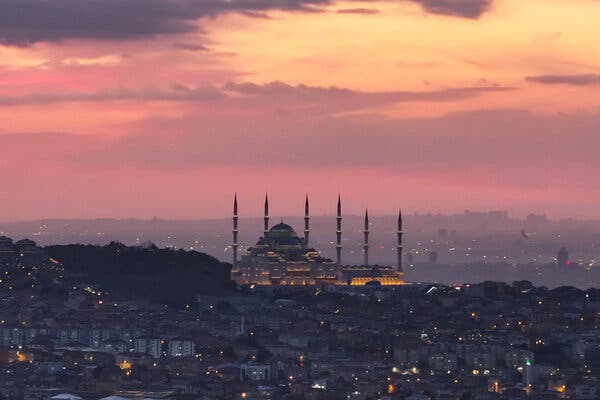Istanbul, a city steeped in the legacies of the Roman, Byzantine, and Ottoman empires, has long been an open-air museum. In recent years, it has enriched its cultural landscape with numerous indoor museums scattered across its iconic seven hills. These institutions occupy a variety of striking spaces, including restored Ottoman baths, repurposed industrial buildings, and bold new architectural designs. Their collections range from ancient Islamic relics to avant-garde contemporary artworks, offering visitors an immersive experience that bridges the city’s rich past with its vibrant 21st-century art scene—a scene set to shine further during this September’s 20th Contemporary Istanbul art fair.
Along the shores of the Bosporus Strait, which divides Istanbul’s European and Asian sides, major developments are underway. Architecture enthusiasts will recognize Renzo Piano’s signature style in the Istanbul Modern museum’s sleek new building, featuring a silver-gray façade, geometric shapes, and a cantilevered design supported by slender columns. This design links it to Piano’s other renowned projects like the Whitney Museum in New York and the Harvard Art Museums expansion.
Inside, visitors find two galleries dedicated to temporary exhibitions alongside a full floor showcasing Turkish art from 1945 onward. Highlights include textured canvases by Albert Bitran, a French artist who lived in Istanbul, and gritty street photography by Ara Guler, whose work is also displayed at the dedicated Ara Guler Museum. A contemporary touch is provided by Halil Altindere’s 2022 digital NFT—a haunting, computer-animated vision of a desolate, post-apocalyptic Earth.
Women artists have a strong presence here, featuring postwar trailblazers such as Fahrelnissa Zeid, known for her vibrant geometric compositions, and Semiha Berksoy, an opera singer whose paintings of female nudes blend humor and poignancy with childlike brushstrokes. Yet, the museum’s true centerpiece may be its panoramic views of Istanbul itself, framed by expansive glass walls and a rooftop reflecting pool that showcase the city’s mosques, towers, and the restless waters of the Bosporus.
Next door, the Istanbul Museum of Painting and Sculpture offers an in-depth look at 19th- and 20th-century Turkish art, tracing influences from the Barbizon school to Anatolian Cubism. Established in the 1930s, the museum now inhabits a striking waterfront building designed by Emre Arolat Architecture. The converted warehouse features a grid-like façade with red protruding boxes, while inside, its industrial-futuristic aesthetic is enhanced by metal-lined corridors and catwalk-style walkways.
The museum’s collection presents a chronological exploration of artistic movements, spanning styles such as socialist realism, political portraiture, Art Deco, and Cubism, each given dedicated gallery space. Particularly powerful are works from the interwar period, including Namik Ismail’s textured depictions of Jazz Age women and Belkis Mustafa’s bold nudes—remarkable both for their artistry and for the artist’s tragic early death at 29. Also notable is Ali Avni Celebi’s 1928 painting “Masquerade Ball,” a vibrant and decadent portrayal of Roaring Twenties revelry.
The recent surge in Istanbul’s cultural venues owes much to initiatives by the city’s municipal government under Mayor Ekrem Imamoglu. Despite political controversies surrounding him, the administration has transformed various former industrial sites, including abandoned gas silos and a century-old water-pumping station, into contemporary exhibition spaces.
Among these revitalizations, the most impressive is the ArtIstanbul Feshane complex on the Golden Horn. This sprawling exhibition venue was reopened last year in a nearly 200-year-old former textile factory, once known for producing men’s fezzes.
Books play a central role at ArtIstanbul Feshane, where a large bookstore offers a wide selection of cultural, historical, biographical, and fictional works in both Turkish and English—including titles like “Constantinople: The Last Great Siege, 1453” and novels by Nobel laureate Orhan Pamuk. An on-site library provides visitors with comfortable seating and thousands of volumes, including comprehensive art encyclopedias.
The venue’s programming is international in scope and often literary in nature. Last year, it featured loaned works from London’s Tate museum. Currently, through September 20, the institution is exhibiting pieces by Turkish artist Ahmet Gunestekin, whose fascination with language is expressed through large-scale sculptural installations—among them, massive white stone shards resting on pedestals made of books.
Dating back to the 1530s, the Zeyrek Cinili Hamam bathhouse was designed by the great Ottoman architect Mimar Sinan, who built many of the empire’s iconic mosques and palaces. The bathhouse’s chambers were once adorned with thousands of hand-painted Iznik tiles, some of which now reside in the Louvre and the Victoria & Albert Museum.
Following years of neglect, this historic hamam was meticulously restored over 13 years and reopened in 2023. It now offers traditional bath and massage experiences alongside multiple exhibition areas dedicated to the hamam’s history and cultural significance.
One courtyard exhibit displays Byzantine-era artifacts such as delicate glassware, terracotta oil lamps, and glazed pottery uncovered during restoration. A museum annex features original Iznik tile fragments and traditional platform shoes worn by hamam visitors in centuries past—crafted from rare woods, precious metals, embroidered fabrics, and mother-of-pearl inlays, each pair is a unique work of art. Additionally, an underground Byzantine cistern, drained and fitted with modern lighting, hosts rotating contemporary art exhibitions. Currently on view is “Murmurations,” a site-specific installation by London-based artist Anousha Payne, running through August 15.
The Museum of Islamic Civilizations, a sleek, dimly lit extension of Turkey’s largest mosque, the Grand Camlica Mosque, contains some of the most delicate and rare artifacts on display. Among these are tiny hairs, just a millimeter long, believed to be from the beard of the Prophet Muhammad, preserved within a slender glass tube.
Spanning two floors, the museum’s extensive collection includes carpets, coins, books, maps, metalwork, and more, all illustrating the rich history and traditions of Islam. A 19th-century calligraphic work traces the Prophet’s lineage back to Adam and Eve, while a section devoted to the Kaaba—the sacred black cube at Islam’s holiest site in Mecca—displays a luxurious 19th-century carpet that once served as its door.
Art lovers and design enthusiasts will appreciate the museum’s exceptional craftsmanship, evident in illuminated manuscripts, intricately patterned caftans, and wooden boxes inlaid with marquetry and mother-of-pearl. For those intrigued by Turkish tiles, multiple glass cases showcase exquisite 16th-century hand-painted Iznik masterpieces.


0 Comments
No comments yet. Be the first to comment!